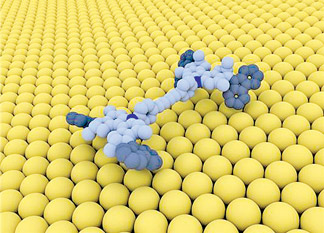Nano car has molecular 4-wheel drive: Smallest electric car in the
world
Reduced to the max: the emission-free, noiseless 4-wheel drive car,
jointly developed by Empa researchers and their Dutch colleagues,
represents lightweight construction at its most extreme.
 The nano car consists of just a single molecule and travels on four
electrically-driven wheels in an almost straight line over a copper
surface. The “prototype” can be admired on the cover of the latest
edition of Nature. The nano car consists of just a single molecule and travels on four
electrically-driven wheels in an almost straight line over a copper
surface. The “prototype” can be admired on the cover of the latest
edition of Nature.
To carry out mechanical work, one usually turns to engines, which
transform chemical, thermal or electrical energy into kinetic energy in
order to, say, transport goods from A to B. Nature does the same thing;
in cells, so-called motor proteins such as kinesin and the muscle
protein actin carry out this task. Usually they glide along other
proteins, similar to a train on rails, and in the process “burn” ATP
(adenosine triphosphate), the chemical fuel, so to speak, of the living
world. A number of chemists aim to use similar principles and concepts
to design molecular transport machines, which could then carry out
specific tasks on the nano scale. According to an article in the latest
edition of science magazine “Nature,” scientists at the University of
Groningen and at Empa have successfully taken “a decisive step on the
road to artificial nano-scale transport systems.” They have synthesised
a molecule from four rotating motor units, i.e. wheels, which can travel
straight ahead in a controlled manner. “To do this, our car needs
neither rails nor petrol; it runs on electricity.
It must be the smallest electric car in the world and it even comes
with 4-wheel drive” comments Empa researcher Karl-Heinz Ernst. Range per
tank of fuel: still room for improvement The downside: the small car,
which measures approximately 4x2 nanometres about one billion times
smaller than a VW Golf needs to be refuelled with electricity after
every half revolution of the wheels via the tip of a scanning tunnelling
microscope (STM). Furthermore, due to their molecular design, the wheels
can only turn in one direction.
“In other words: there’s no reverse gear,” says Ernst, who is also a
professor at the University of Zurich, laconically. According to its
“construction plan” the drive of the complex organic molecule functions
as follows: after sublimating it onto a copper surface and positioning
an STM tip over it leaving a reasonable gap, Ernst’s colleague, Manfred
Parschau, applied a voltage of at least 500 mV. Now electrons should
“tunnel” through the molecule, thereby triggering reversible structural
changes in each of the four motor units. It begins with a cis-trans
isomerisation taking place at a double bond, a kind of rearrangement in
an extremely unfavourable position in spatial terms, though, in which
large side groups fight for space.
As a result, the two side groups tilt to get past each other and end
up back in their energetically more favourable original position the
wheel has completed a half turn.
If all four wheels turn at the same time, the car should travel
forwards. At least, according to theory based on the molecular
structure.
To drive or not to drive a simple question of orientation And this is
what Ernst and Parschau observed: after ten STM stimulations, the
molecule had moved six nanometres forwards in a more or less straight
line.
“The deviations from the predicted trajectory result from the fact
that it is not at all a trivial matter to stimulate all four motor units
at the same time,” explains “test driver” Ernst.
ScienceDaily
|

